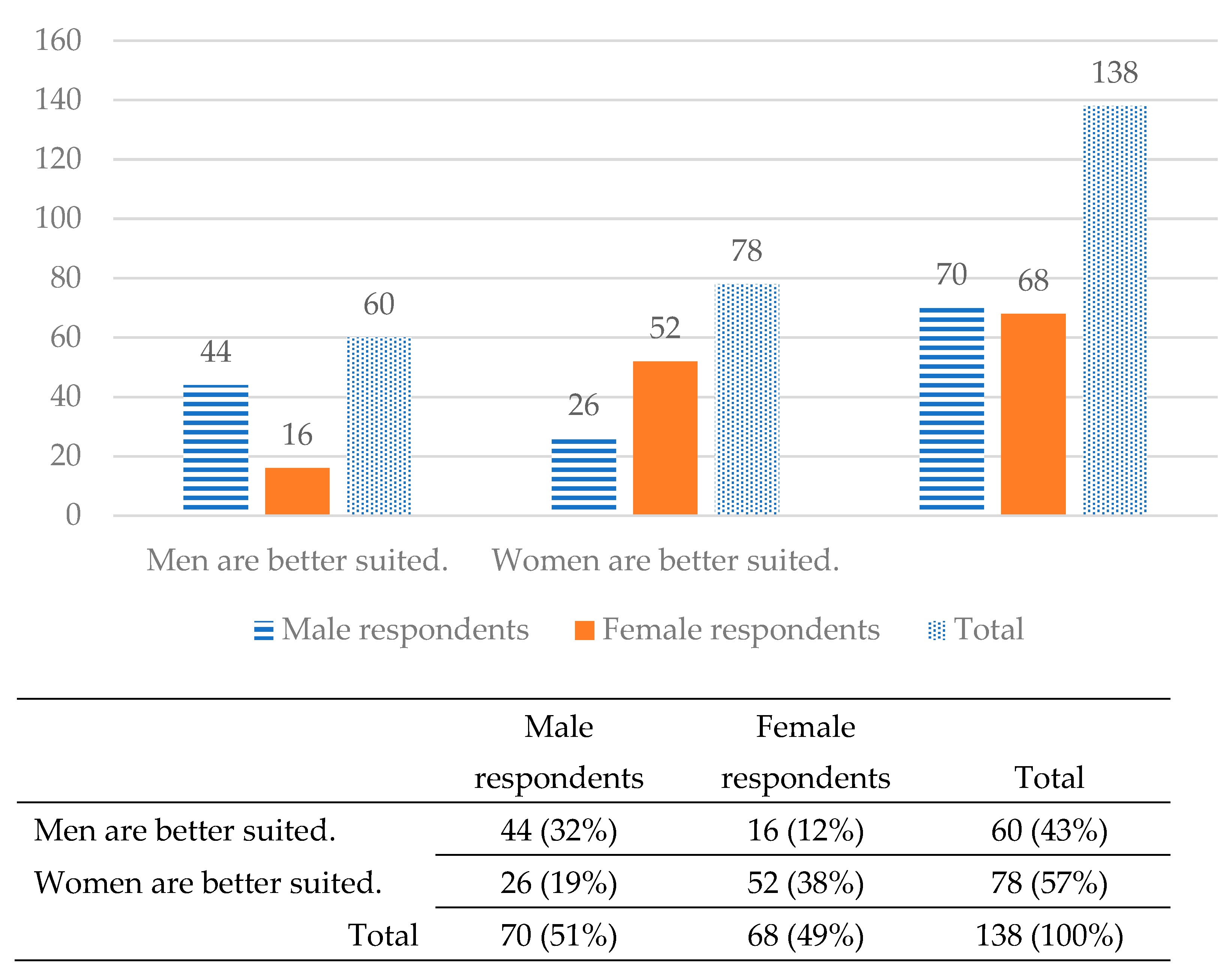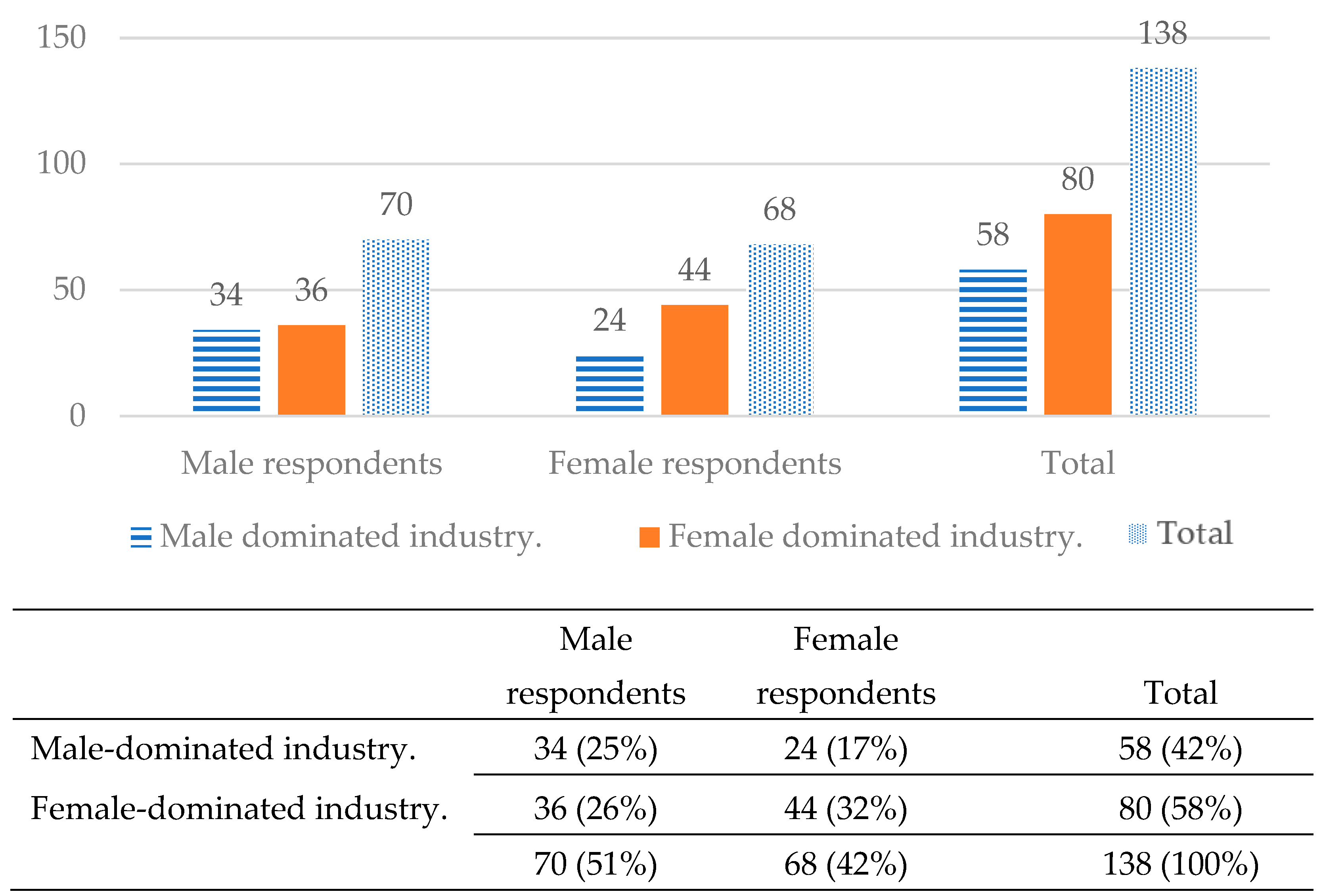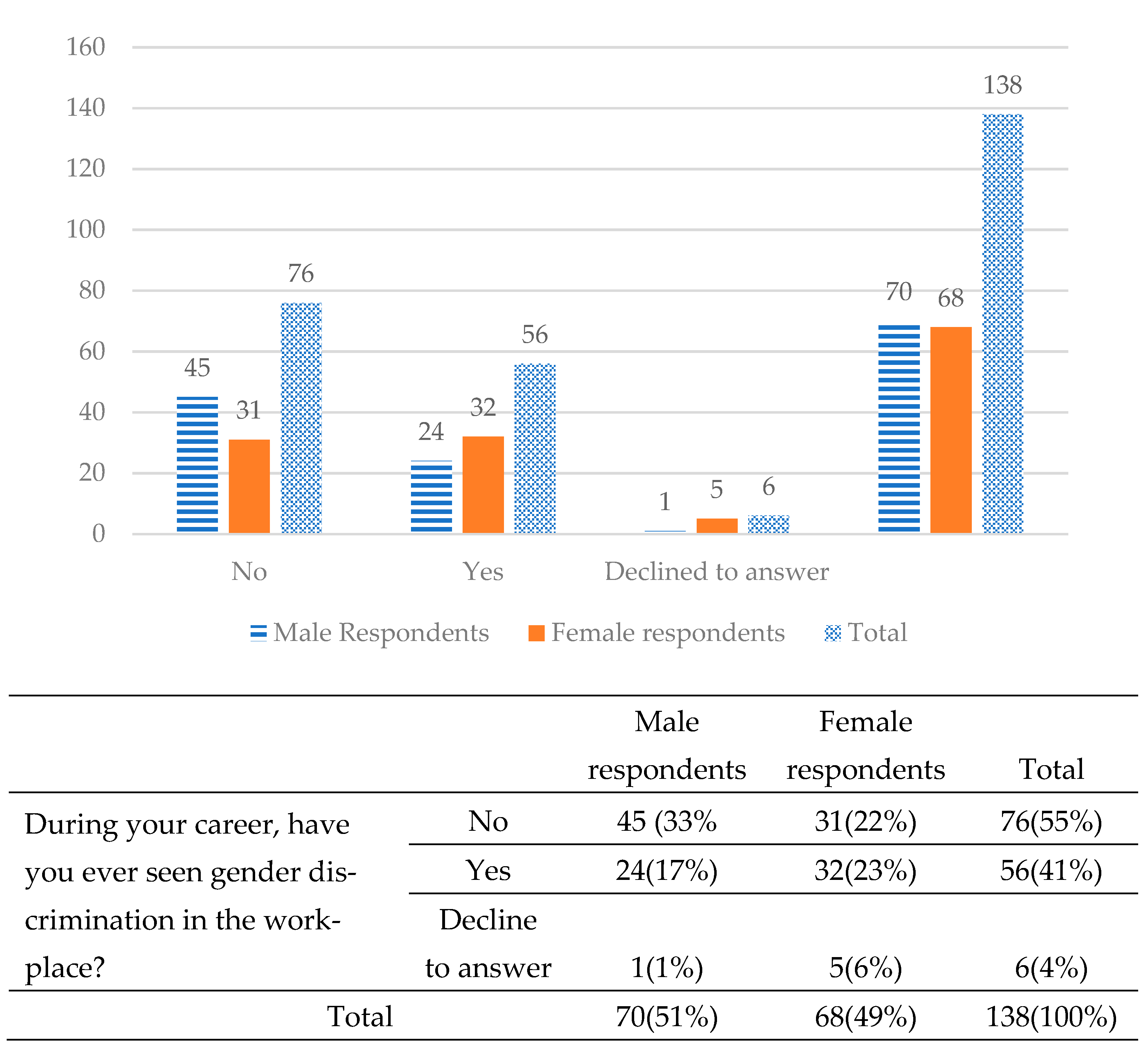Gender Roles, Gender Bias, and Cultural Influences: Perceptions of Male and Female UAE Public Relations Professionals
Abstract
:1. Introduction
2. Literature Review
2.1. Gender Equality in Organizations and Workplaces
2.2. Gender Perceptions and Their Impact on Workplace Dynamics
2.3. Gender Issues at the Intersection of Societal Structures and Workplace Realities
Public Relations Industry in the UAE
3. Methodology
Research and Questionnaire Design
4. Results
4.1. Sample Demographic Characteristics
4.2. RQ1: To What Extent Do PR Professionals in the UAE Perceive Gender Equality Issues?
4.3. RQ2: Do Male and Female PR Practitioners Perceive Gender Equality Issues Differently?
4.4. RQ3: To What Extent Do PR Professionals in the UAE Experience Gender Bias in the Workplace?
5. Conclusions
Author Contributions
Funding
Institutional Review Board Statement
Informed Consent Statement
Data Availability Statement
Conflicts of Interest
References
- Abalkhail, Jouharah M. 2019. Women’s career development in an Arab Middle Eastern context. Human Resource Development International 22: 177–99. [Google Scholar] [CrossRef]
- Abuhussein, Tala, and Tamer Koburtay. 2021. Opportunities and constraints of women entrepreneurs in Jordan: An update of the 5Ms framework. International Journal of Entrepreneurial Behavior & Research 27: 1448–75. [Google Scholar]
- Acker, Joan. 1990. Hierarchies, jobs, bodies: A theory of gendered organizations. Gender & Society 4: 139–58. [Google Scholar]
- Aldoory, Linda. 2009. How Gender Can Impact Public Relations Texts and Contexts. Rhetorical and Critical Approaches to Public Relations II: 110. [Google Scholar]
- Aldoory, Linda, and Elizabeth Toth. 2002. Gender discrepancies in a gendered profession: A developing theory for public relations. Journal of Public Relations Research 14: 103–26. [Google Scholar] [CrossRef]
- Al Fardan, Mashael, and Belisa Marochi. 2021. Implementation of Gender Policies by the Private Sector in the UAE: Challenges and Opportunities. Journal for Interdisciplinary Middle Eastern Studies 7: 65–86. [Google Scholar] [CrossRef]
- Al Khayyal, Asma Omran, Muhammad Alshurideh, Barween Al Kurdi, and Said A. Salloum. 2020. Women empowerment in UAE: A systematic review. In Proceedings of the International Conference on Advanced Intelligent Systems and Informatics. Cham: Springer International Publishing, pp. 742–55. [Google Scholar]
- Amis, John M., Johanna Mair, and Kamal A. Munir. 2020. The organizational reproduction of inequality. Academy of Management Annals 14: 195–230. [Google Scholar] [CrossRef]
- Bechtoldt, Myriam N., Christina E. Bannier, and Björn Rock. 2019. The glass cliff myth?–Evidence from Germany and the UK. The Leadership Quarterly 30: 273–97. [Google Scholar] [CrossRef]
- Bridges, Donna, Elizabeth Wulff, and Larissa Bamberry. 2023. Resilience for gender inclusion: Developing a model for women in male-dominated occupations. Gender, Work & Organization 30: 263–79. [Google Scholar]
- Chang, Edward H., and Katherine L. Milkman. 2020. Improving decisions that affect gender equality in the workplace. Organizational Dynamics 49: 100709. [Google Scholar] [CrossRef]
- Cline, Carolyn Garrett, Elizabeth Lance Toth, Judy Valensky Turk, Lynne Masel Walters, Nancy Johnson, and Hank Smith. 1986. The Velvet Ghetto: The Impact of the Increasing Percentage of Women in Public Relations and Business Communication. San Francisco: IABC Foundation. [Google Scholar]
- Connell, Raewyn. 2006. Glass ceilings or gendered institutions? Mapping the gender regimes of public sector worksites. Public Administration Review 66: 837–49. [Google Scholar] [CrossRef]
- Crites, Stephanie N., Kevin E. Dickson, and Alicia Lorenz. 2015. Nurturing gender stereotypes in the face of experience: A study of leader gender, leadership style, and satisfaction. Journal of Organizational Culture, Communications and Conflict 19: 1. [Google Scholar]
- Dellinger, Kirsten, and Christine L. Williams. 1997. Makeup at work: Negotiating appearance rules in the workplace. Gender & Society 11: 151–77. [Google Scholar]
- Dubai Women Establishment. 2023. Available online: https://dwe.gov.ae/en/stats-facts (accessed on 19 November 2023).
- Ellemers, Naomi. 2018. Gender stereotypes. Annual Review of Psychology 69: 275–98. [Google Scholar] [CrossRef]
- European Institute for Gender Equality. n.d. Gender Equality Index 2022: Gender Equality under Threat, Specific Groups Hardest Hit. Available online: https://eige.europa.eu/news/gender-equality-index-2022-gender-equality-under-threat-specific-groups-hardest-hit (accessed on 23 September 2023).
- Figueroa Vélez, Juana, and Susana Vélez Ochoa. 2021. Gender Sensitivity and Its Relation to Gender Equality. In Gender Equality. Cham: Springer, pp. 632–45. [Google Scholar]
- Fitch, Kate. 2016. Professionalizing Public Relations: History, Gender and Education. Berlin/Heidelberg: Springer. [Google Scholar]
- Hatfield, Elaine, Michael Salmon, and Richard L. Rapson. 2011. Equity theory and social justice. Journal of Management, Spirituality & Religion 8: 101–21. [Google Scholar]
- Heath, Robert L. 2006. Onward into more fog: Thoughts on public relations’ research directions. Journal of Public Relations Research 18: 93–114. [Google Scholar] [CrossRef]
- Heilman, Madeline E. 2012. Gender stereotypes and workplace bias. Research in organizational Behavior 32: 113–35. [Google Scholar] [CrossRef]
- Heilman, Madeline E., and Suzette Caleo. 2018. Combatting gender discrimination: A lack of fit framework. Group Processes & Intergroup Relations 21: 725–44. [Google Scholar]
- Horsley, J. Suzanne. 2009. Women’s contributions to American public relations, 1940–1970. Journal of Communication Management 13: 100–15. [Google Scholar] [CrossRef]
- Hozić, Aida A., and Jacqui True. 2017. Brexit as a scandal: Gender and global trumpism. Review of International Political Economy 24: 270–87. [Google Scholar]
- Inuwa, Mohammed. 2017. Relationship between job equity and performance of employee: A literature review. International Journal of Business and Management Future 1: 8–15. [Google Scholar] [CrossRef]
- Irvine, Leslie, and Jenny R. Vermilya. 2010. Gender work in a feminized profession: The case of veterinary medicine. Gender & Society 24: 56–82. [Google Scholar]
- Kirat, Mohamed. 2006. Public relations in the United Arab Emirates: The emergence of a profession. Public Relations Review 32: 254–60. [Google Scholar] [CrossRef]
- Lee, Hyunmin, Katie R. Place, and Brian G. Smith. 2018. Revisiting gendered assumptions of practitioner power: An exploratory study examining the role of social media expertise. Public Relations Review 44: 191–200. [Google Scholar] [CrossRef]
- Madden, Stephanie, and Abbey Levenshus. 2021. Broadening the umbrella of women’s leadership and public relations: An ethnographic case study of a women’s political leadership development program. Journal of Public Relations Research 33: 168–84. [Google Scholar] [CrossRef]
- Meng, Juan, and Marlene S. Neill. 2021. Inclusive leadership and women in public relations: Defining the meaning, functions, and relationships. Journal of Public Relations Research 33: 150–67. [Google Scholar] [CrossRef]
- Millett, Kate. 2016. Sexual Politics. New York City: Columbia University Press. [Google Scholar]
- Mir-Hosseini, Ziba. 2022. Journeys toward Gender Equality in Islam. London: Oneworld academic. [Google Scholar]
- MNFCA. 2007. Women in the United Arab Emirates: A Portrait of Progress. Available online: https://www.ohchr.org/sites/default/files/lib-docs/HRBodies/UPR/Documents/Session3/AE/UPR_UAE_ANNEX3_E.pdf (accessed on 25 October 2023).
- Organisation for Economic Cooperation and Developmen. 2017. Gender Balance Guide. Available online: https://www.oecd.org/gov/gender-balance-guide-uae-2017.pdf (accessed on 22 September 2023).
- Parker, Kim, and Cary Funk. 2017. Gender Discrimination Comes in Many Forms for Today’s Working Women. Pew Research Center 14.42% of US Working Women Have Faced Gender Discrimination on the Job | Pew Research Center. Available online: https://www.pewresearch.org/short-reads/2017/12/14/gender-discrimination-comes-in-many-forms-for-todays-working-women/ (accessed on 12 September 2023).
- Patterson, Louise, Damodharan Sowmya Varadarajan, and Beena Saji Salim. 2021. Women in STEM/SET: Gender gap research review of the United Arab Emirates (UAE)—A meta-analysis. Gender in Management: An International Journal 36: 881–911. [Google Scholar] [CrossRef]
- Pillay-Naidoo, Daphne, and Corlette Vermeulen. 2023. Seeking support through solidarity: Female leader’s experiences of workplace solidarity in male-dominated professions. Frontiers in Psychology 14. [Google Scholar] [CrossRef]
- Place, Katie R., and Jennifer Vardeman-Winter. 2018. Where are the women? An examination of research on women and leadership in public relations. Public Relations Review 44: 165–73. [Google Scholar] [CrossRef]
- Prager, Laila. 2020. Emirati Women Leaders in the Cultural Sector: From “State Feminism” to Empowerment? Hawwa 18: 51–74. [Google Scholar] [CrossRef]
- Rolleri, C. 2013. Gender equality. European Scientific Journal 9: 1857–7881. [Google Scholar]
- The Securities and Commodities Authority. 2021. The SCA Board Makes It Mandatory for Listed Companies to Comply with the Percentage of Women’s Representation on Their Boards|News|Media Center|Securities and Commodities Authority. Available online: https://www.sca.gov.ae/en/media-center/news/14/3/2021/board-of-directors-of-sca-approves-the-obligation-of-listed-companies-to-represent-women-in-the.aspx (accessed on 5 October 2023).
- Smith, Amy E., and Karen R. Monaghan. 2013. Some ceilings have more cracks: Representative bureaucracy in federal regulatory agencies. The American Review of Public Administration 43: 50–71. [Google Scholar] [CrossRef]
- Stamarski, Cailin S., and Leanne S. Son Hing. 2015. Gender inequalities in the workplace: The effects of organizational structures, processes, practices, and decision makers’ sexism. Frontiers in Psychology 6: 1400. [Google Scholar] [CrossRef]
- Tafvelin, Susanne, Britt-Inger Keisu, and Elin Kvist. 2020. The prevalence and consequences of intragroup conflicts for employee well-being in women-dominated work. Human Service Organizations: Management, Leadership & Governance 44: 47–62. [Google Scholar]
- The UN Foundation. 2022. The Best, the Worst, the Most Surprising, and Most Ridiculous. Available online: https://unfoundation.org/blog/post/gender-equality-in-2022-the-best-the-worst-the-most-surprising-and-most-ridiculous/ (accessed on 24 September 2023).
- Toth, Elizabeth Lance, and Carolyn Garrett Cline, eds. 1989. Beyond the Velvet Ghetto. Chicago: IABC Research Foundation. [Google Scholar]
- Toth, Elizabeth L., and Larissa A. Grunig. 1993. The missing story of women in public relations. Journal of Public Relations Research 5: 153–75. [Google Scholar] [CrossRef]
- Topić, Martina. 2021. Introduction to special issue: Women and leadership in public relations. Journal of Public Relations Research 33: 131–35. [Google Scholar] [CrossRef]
- Topić, Martina, Maria Joäo Cunha, Amelia Reigstad, Alenka Jelen-Sanchez, and Ángeles Moreno. 2020. Women in public relations (1982–2019). Journal of Communication Management 24: 391–407. [Google Scholar] [CrossRef]
- UAE Gender Balance Council. 2023. UAE Women FAQs. Available online: https://www.google.com/search?q=percentage+of+females+in+higher+education+in+uae&rlz=1C1GCEU_enAE1024AE1024&oq=percentage+of+females+in+higher+education+in+uae&aqs=chrome..69i57j0i546l5.12902j1j7&sourceid=chrome&ie=UTF-8 (accessed on 11 October 2023).
- Van Laer, Koen, Marijke Verbruggen, and Maddy Janssens. 2021. Understanding and addressing unequal career opportunities in the ‘new career’era: An analysis of the role of structural career boundaries and organizational career management. The International Journal of Human Resource Management 32: 3547–67. [Google Scholar] [CrossRef]
- Welborne, Bozena C., and Gail J. Buttorff. 2022. Gender quotas in the Arab world-20 years on. Digest of Middle East Studies 31: 340–58. [Google Scholar] [CrossRef]
- Wright, Donald K. 2020. Re-examining the existence of the “velvet ghetto” and the “glass ceiling”: Examining the status of American women in public relations a generation later. In Women in PR History. London: Routledge, pp. 9–17. [Google Scholar]
- Wynn, Alison T., and Shelley J. Correll. 2018. Combating gender bias in modern workplaces. In Handbook of the Sociology of Gender. Cham: Springer, pp. 509–21. [Google Scholar]




| Mean (SD) | ||
|---|---|---|
| Age | 33.88 (9.34) | |
| Work Experience (Years) | 10.39 (9.42) | |
| Frequency (%) | ||
| Sex | Male | 70 (50.7) |
| Female | 68 (49.3) | |
| Nationality | UAE | 95 (68.8) |
| Arab country | 22 (16) | |
| Other | 21 (15.2) | |
| Work Position | Assistant/Associate | 24 (17.4) |
| Assistant Manager | 18 (13.0) | |
| Manger | 25 (18.1) | |
| Senior Manager | 11 (8.0) | |
| Director | 9 (6.5) | |
| Executive | 27 (17.4) | |
| Other | 27 (19.6) | |
| Employment | Private sector | 72 (52.2) |
| Government sector | 43 (31.2) | |
| Nonprofit/NGO | 13 (9.4) | |
| Other | 10 (7.2) | |
| Education | Some high school or less | 9 (6.5) |
| High school diploma or GED | 11 (8.0) | |
| Some college, but no degree | 5 (3.6) | |
| Associates or technical degree | 8 (5.8) | |
| Bachelor’s degree | 63 (45.7) | |
| Master’s or higher | 37 (26.8) | |
| Prefer not to say | 5 (3.6) |
| Mean (SD) | ||||
|---|---|---|---|---|
| Combined * | Male | Female | t-Value | |
| Gender Equality | ||||
| Gender stereotyping exists in the workplaces. | 4.56 (1.78) | 4.37 (1.89) | 4.76 (1.65) | −1.31 |
| Gender equality is important in the workplaces. | 5.19 (1.79) | 4.96 (1.79 | 5.44 (1.77) | −1.70 ** |
| PR industry promotes towards gender equality. | 4.78 (1.73) | 4.64 (1.90) | 4.92 (1.52) | −1.07 |
| Government’s equality efforts have seen progress. | 4.83 (1.51) | 4.76 (1.87) | 4.91 (1.51) | −0.69 |
| Gender Roles | ||||
| Men are under-represented. | 4.13 (1.89) | 4.29 (1.96) | 3.97 (1.81) | 1.02 |
| Men are paid more salary than women. | 4.51 (1.88) | 4.30 (1.88) | 4.74 (1.860 | −1.26 |
| Men are offered more opportunities for promotion. | 4.59 (1.69) | 4.40 (1.74) | 4.79 (1.62) | −1.31 |
| Men are assigned for more important tasks. | 4.71 (1.62) | 4.69 (1.78) | 4.74 (1.49) | −0.28 |
| Influence of Culture on Gender Equality | ||||
| Influence gender equality in my workplace. | 4.70 (1.70) | 4.71 (1.81) | 4.68 (1.58) | 0.13 |
| Influence gender equality in the PR industry. | 4.83 (1.52) | 4.80 (1.54) | 4.86 (1.51) | −0.20 |
| Policies and practices support gender equality. | 5.01 (1.52) | 5.01 (1.62) | 5.02 (1.42) | −0.12 |
| Gender equality impacts work performance. | 4.86 (1.68) | 4.71 (1.72) | 5.02 (1.63) | −0.94 |
| Gender equality will improve in the future. | 5.10 (1.70) | 4.84 (1.85) | 5.36 (1.51) | −1.84 ** |
Disclaimer/Publisher’s Note: The statements, opinions and data contained in all publications are solely those of the individual author(s) and contributor(s) and not of MDPI and/or the editor(s). MDPI and/or the editor(s) disclaim responsibility for any injury to people or property resulting from any ideas, methods, instructions or products referred to in the content. |
© 2023 by the authors. Licensee MDPI, Basel, Switzerland. This article is an open access article distributed under the terms and conditions of the Creative Commons Attribution (CC BY) license (https://creativecommons.org/licenses/by/4.0/).
Share and Cite
Lee, S.; Alsereidi, R.H.; Ben Romdhane, S. Gender Roles, Gender Bias, and Cultural Influences: Perceptions of Male and Female UAE Public Relations Professionals. Soc. Sci. 2023, 12, 673. https://doi.org/10.3390/socsci12120673
Lee S, Alsereidi RH, Ben Romdhane S. Gender Roles, Gender Bias, and Cultural Influences: Perceptions of Male and Female UAE Public Relations Professionals. Social Sciences. 2023; 12(12):673. https://doi.org/10.3390/socsci12120673
Chicago/Turabian StyleLee, Sang, Raya Hamad Alsereidi, and Samar Ben Romdhane. 2023. "Gender Roles, Gender Bias, and Cultural Influences: Perceptions of Male and Female UAE Public Relations Professionals" Social Sciences 12, no. 12: 673. https://doi.org/10.3390/socsci12120673
APA StyleLee, S., Alsereidi, R. H., & Ben Romdhane, S. (2023). Gender Roles, Gender Bias, and Cultural Influences: Perceptions of Male and Female UAE Public Relations Professionals. Social Sciences, 12(12), 673. https://doi.org/10.3390/socsci12120673







